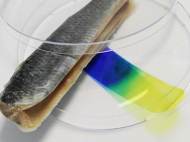Sensor film could help in food quality control
 A while ago we wrote about folks from Fraunhofer who came up with active packaging that increases shelf life of spoilable products, and their colleagues came up with a way to indicate whether the food on the shelf is already spoiled due to errors which could occur before the food is packaged, or due to mistake in packaging. They have developed a sensor film that can be integrated into the package itself, where it takes over the role of quality control.
A while ago we wrote about folks from Fraunhofer who came up with active packaging that increases shelf life of spoilable products, and their colleagues came up with a way to indicate whether the food on the shelf is already spoiled due to errors which could occur before the food is packaged, or due to mistake in packaging. They have developed a sensor film that can be integrated into the package itself, where it takes over the role of quality control.
The sensor film, developed by the Fraunhofer Research Institution for Modular Solid State Technologies EMFT in Munich, changes color in order to announce if food has started to become spoiled. The sensor film is integrated into the inside of the packaging, where it responds to biogenic amines. Amines are molecules produced when foods – especially fish and meat – decay. They are also responsible for their unpleasant smell. If amines are released into the air within the packaging, the indicator dye on the sensor film reacts with them and changes its color from yellow to blue.
“Unlike the expiration date, the information on the sensor film is not based on an estimate but on an actual control of the food itself”, said Dr. Anna Hezinger, a scientist at EMFT (available in German language).
Aside indication itself, this system is important because many people are extremely sensitive to the presence of certain amines. Its developers claim that the system is very inexpensive and usable on a broad scale. Other solutions – such as electronic sensors, for instance – would lead to a steep increase in the price of packaged meat.
“Food safety is ensured by a barrier layer between the sensor film and the product itself. This barrier is only permeable to gaseous amines. The indicator chemicals cannot pass through”, said Hezinger.
Scientists are also working on a measurement module with a built-in sensor film. Employees in the food and packaging industries could use the module to test the freshness of food products directly. The device objectively analyses the color response while at the same time providing a more precise result than is possible with the human eye. This also permits an exact identification of intermediate shades of color.
Dr. Anna Hezinger and her team are currently looking for partners in industry with which to further develop and produce the sensor film and measurement module.









Leave your response!